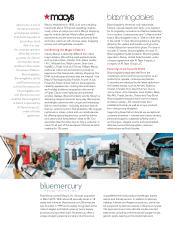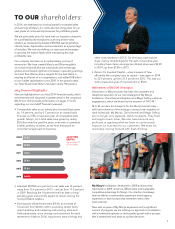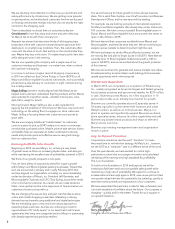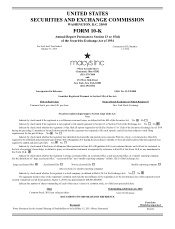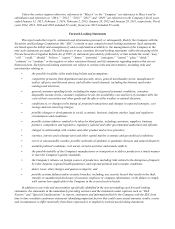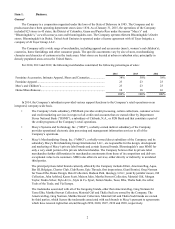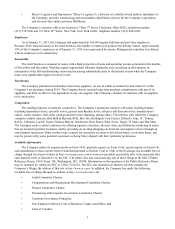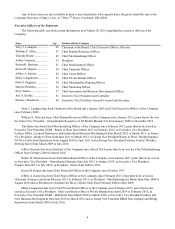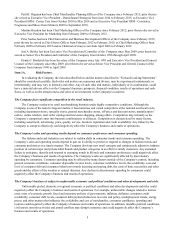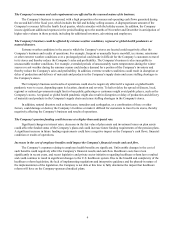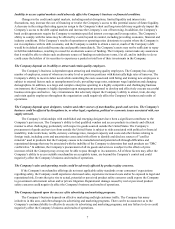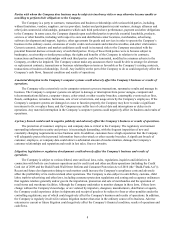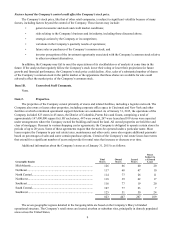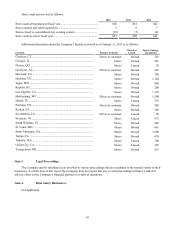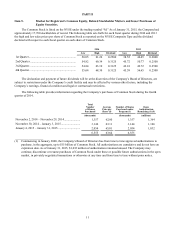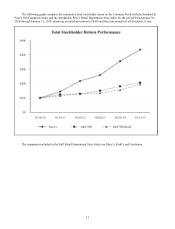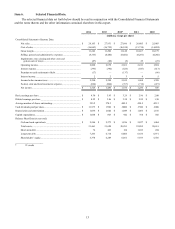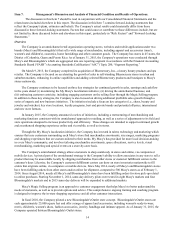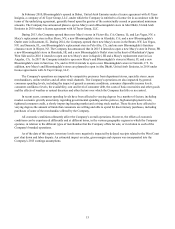Macy's 2014 Annual Report Download - page 10
Download and view the complete annual report
Please find page 10 of the 2014 Macy's annual report below. You can navigate through the pages in the report by either clicking on the pages listed below, or by using the keyword search tool below to find specific information within the annual report.5
Patti H. Ongman has been Chief Merchandise Planning Officer of the Company since February 2015; prior thereto
she served as Executive Vice President - Omnichannel Strategies from June 2014 to February 2015; as Executive Vice
President GMM - Center Core from October 2010 to May 2014 and as Executive Vice President GPM - Cosmetics,
Fragrances and Shoes from February 2009 to September 2010.
Martine Reardon has been Chief Marketing Officer of the Company since February 2012; prior thereto she served as
Executive Vice President for Marketing from February 2009 to February 2012.
Peter Sachse has been Chief Innovation and Business Development Officer of the Company since February 2015;
prior thereto he served as Chief Stores Officer from February 2012 to February 2015; as Chief Marketing Officer from
February 2009 to February 2012 and as Chairman of macys.com from April 2006 to February 2012.
Joel A. Belsky has been Executive Vice President and Controller of the Company since May 2009; prior thereto he
served as Senior Vice President and Controller of the Company from October 1996 through April 2009.
Dennis J. Broderick has been Secretary of the Company since July 1993 and Executive Vice President and General
Counsel of the Company since May 2009; prior thereto he served as Senior Vice President and General Counsel of the
Company from January 1990 to April 2009.
Item 1A. Risk Factors.
In evaluating the Company, the risks described below and the matters described in “Forward-Looking Statements”
should be considered carefully. Such risks and matters are numerous and diverse, may be experienced continuously or
intermittently, and may vary in intensity and effect. Any of such risks and matters, individually or in combination, could
have a material adverse effect on the Company's business, prospects, financial condition, results of operations and cash
flows, as well as on the attractiveness and value of an investment in the Company's securities.
The Company faces significant competition in the retail industry.
The Company conducts its retail merchandising business under highly competitive conditions. Although the
Company is one of the nation’s largest retailers, it has numerous and varied competitors at the national and local levels,
including department stores, specialty stores, general merchandise stores, off-price and discount stores, manufacturers’
outlets, online retailers, mail order catalogs and television shopping, among others. Competition may intensify as the
Company’s competitors enter into business combinations or alliances. Competition is characterized by many factors,
including assortment, advertising, price, quality, service, location, reputation and credit availability. Any failure by the
Company to compete effectively could negatively affect the Company's business and results of operations.
The Company’s sales and operating results depend on consumer preferences and consumer spending.
The fashion and retail industries are subject to sudden shifts in consumer trends and consumer spending. The
Company’s sales and operating results depend in part on its ability to predict or respond to changes in fashion trends and
consumer preferences in a timely manner. The Company develops new retail concepts and continuously adjusts its industry
position in certain major and private-label brands and product categories in an effort to satisfy customers. Any sustained
failure to anticipate, identify and respond to emerging trends in lifestyle and consumer preferences could negatively affect
the Company’s business and results of operations. The Company’s sales are significantly affected by discretionary
spending by consumers. Consumer spending may be affected by many factors outside of the Company’s control, including
general economic conditions, consumer disposable income levels, consumer confidence levels, the availability, cost and
level of consumer debt and consumer behaviors towards incurring and paying debt, the costs of basic necessities and other
goods and the effects of the weather or natural disasters. Any decline in discretionary spending by consumers could
negatively affect the Company's business and results of operations.
The Company’s business is subject to unfavorable economic and political conditions and other developments and risks.
Unfavorable global, domestic or regional economic or political conditions and other developments and risks could
negatively affect the Company’s business and results of operations. For example, unfavorable changes related to interest
rates, rates of economic growth, fiscal and monetary policies of governments, inflation, deflation, consumer credit
availability, consumer debt levels, consumer debt payment behaviors, tax rates and policy, unemployment trends, energy
prices, and other matters that influence the availability and cost of merchandise, consumer confidence, spending and
tourism could negatively affect the Company’s business and results of operations. In addition, unstable political conditions,
civil unrest, terrorist activities and armed conflicts may disrupt commerce and could negatively affect the Company’s
business and results of operations.


